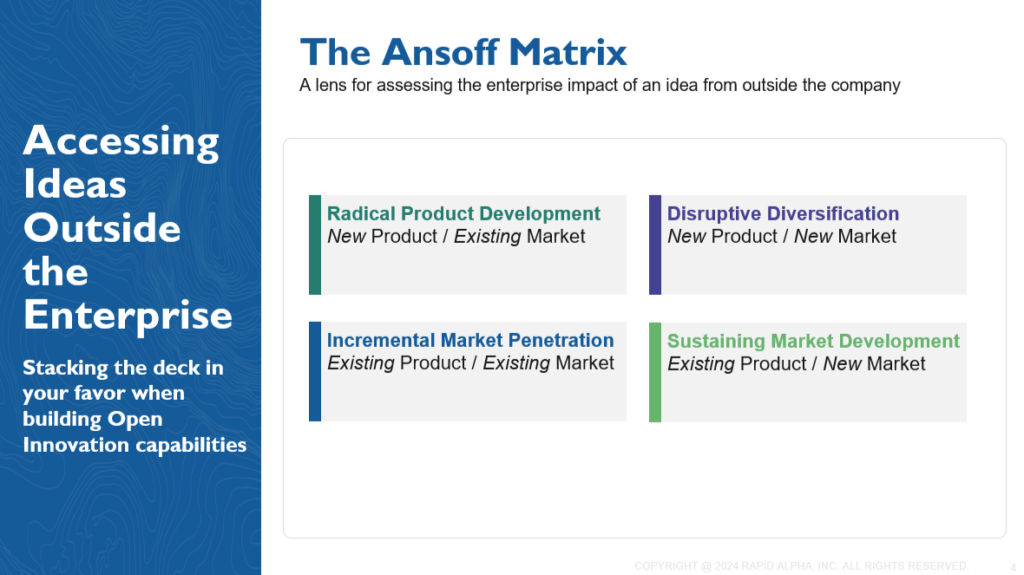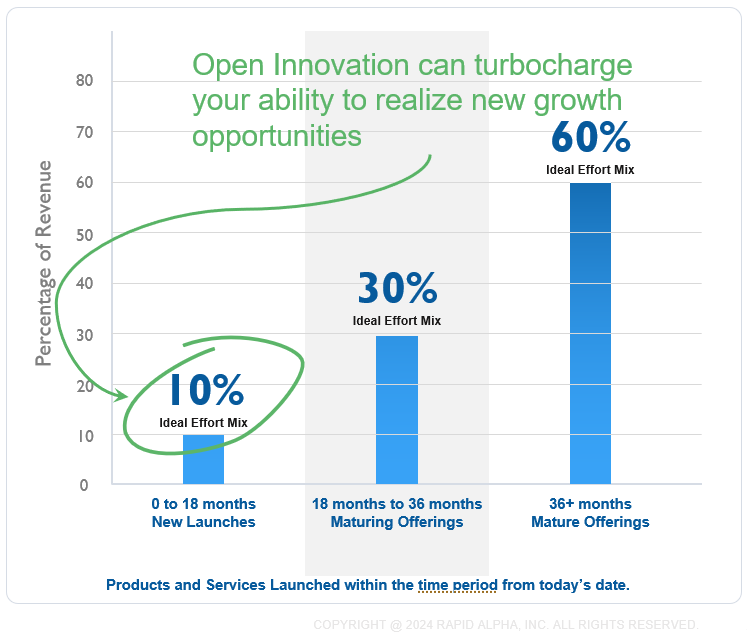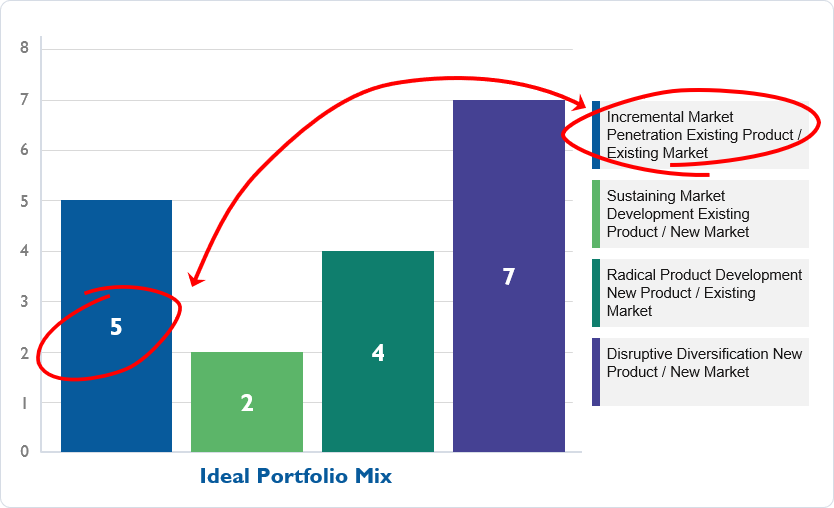
Maybe you have had your eye on some very compelling technology for a while but have not been sure how to pull that tech into your enterprise.
Perhaps you have seen the benefits of Open Innovation at a previous employer and want to develop this skill within your new team.
It could be that you attempted to pull in an exciting idea that inexplicably failed miserably to gain traction.
You are not alone.
At some point in a successful company, the lowest risk/highest ROI opportunities will exist outside your company. To realize the benefits of these technologies within your business, at some point, every company must figure out ways to access the innovations of others in a mutually beneficial paradigm or lose growth opportunities to those who can. With this realization, and against the backdrop of emerging technologies like AI, an evolving political landscape, and an uncertain economic outlook, more volatility means more opportunity. This opportunity is opening the door to Open Innovation.
Open Innovation and phased acquisitions represent compelling tools and philosophies to access technologies quickly and efficiently assess their market impact. Within these principles exist guidelines for managing the significant distraction to financial and reputational damage that can arise when Open Innovation efforts fail. But adding BUY capabilities to a traditional approach of “we build everything ourselves” means you will have to develop a new skill set within your company.
If you love enriching the ecosystem around you with growth opportunities and creating professional development scenarios within your business, becoming proficient with Open Innovation is going to be worth the heartburn.
And there will be heartburn.
So how do you take your first step into the world of Open Innovation?
The clearer path to success is to reduce the number of “new” skills you will have to cultivate in order to develop a return on investment (ROI) on your first Open Innovation opportunity. Laser focus on OI initiatives that cause the least disruption to existing activities gives your team the opportunity to apply the skills they already have to the new elements that inevitably surround OI efforts. Doing so allows your team to gain experience validating opportunities, negotiating deals, managing intellectual property, and integrating sales and marketing to drive sales.

Prioritizing Incremental Innovation
Start with low-risk, incremental improvements to your existing product or solutions that are logical add-ons. Incremental improvements are defined as changes to existing product lines within markets you already operate in. Examples of incremental opportunities might include:
Companion technologies that support your existing solutions in the value chain—for example, technologies that enhance performance and ease of use, result in improved outcomes either before, during, or after deployment. For software companies this may represent an improvement to a user interface, increasing processing speed, or adding new integration capabilities. For physical device manufactures, substituting existing components with more sustainable materials or packaging, extending battery life, reducing form factor, or enhancing connectivity capabilities.
But why focus here?
If your metric for success is driving new revenue, charging more for an existing product, or enhancing your profit margin, many contributors in your company and many outside your team play crucial roles in realizing the outcomes you are aiming for. These roles include legal, product development, sales, and marketing. Starting with an incremental improvement to an existing solution you sell allows your team to focus on their roles rather than mastering a new technology.
Technical Team Support
Your technical team is more likely to be familiar with and skilled at integrating incremental innovation solutions, reducing the learning curve that normally accompanies brand-new product offerings. Businesses with success historically with incremental improvements will have the project management skills they need to work with this concept. For businesses with less of a track record with successful launches and scaling of new product offerings, keeping the technical sophistication on the “readily understandable” can reduce technical hurdles as well as political strife. With incremental innovation, your existing technical resources success are more likely to deliver successful outcomes.

I’d like to tell you that your technical team is going to love the idea of technology coming in from outside the company. I’d like to tell you they will immediately see this as an opportunity for professional growth, and how this technology may open up new exciting areas to experiment. The reality is the common reaction is a “not-invented-here” response. Overcoming not invented here requires giving the technical team ownership and involvement in realizing the desired outcome. What follows are some tips in influencing your technical team to support the effort.
One effective strategy is to encourage them to explore potential improvements or customization. This way, the technical team not only owns the integration but also has a seat at the table for the next round of innovation, empowering them to shape its future evolution.
Another potential challenge is resistance to change or fear of obsolescence. Team members may feel that external innovations threaten their existing skills or job security. Sticking with incremental innovations is a way to frame the integration as leveraging their existing expertise with existing solutions. Realizing a positive outcome on this OI initiative creates the skill the technical team can leverage to bring in opportunities they see as promising. Every company seems to have one creative person with whom this opportunity will really resonate. If you just thought of a person, THAT is YOUR person. If you can partner with this individual, this line of reasoning may be all you need to get them on board.
Communication gaps between the technical team and sales or marketing departments can kill an effort or elevate the results to new heights. To realize the latter rather than the former, start with the strategic reasons behind adapting the OI technology.
If all of this ALREADY seems like a lot of work, be thankful you are starting your initiative with an incremental improvement.
Marketing Support: A Familiar Ideal Customer Profile (ICP)
When you start with an incremental improvement, you position your marketing support for success. After all, your marketing team already knows your Ideal Customer Profile (ICP). They may even have primary market research on your OI opportunity. Even if they don’t, identifying the new pain points solved by the OI incremental innovation is within their current expertise. Importantly, they won’t have to adjust to a completely different buyer persona, allowing them to focus on refining messaging for a familiar market.
Leveraging existing communication channels, your current advocacy network, and advertising platforms save time and reduce tension. Marketing an incremental innovation keeps things manageable while giving your team valuable experience in handling external innovations. Marketing an incremental improvement remains manageable while providing valuable experience in handling external innovations, allowing for faster iteration and feedback cycles.
Partnering with marketing early makes a big difference in realizing significant sales early on. Finding opportunities to announce the partnership, share the new capability in the corporate newsletter, support the marketing team by creating collateral for the next trade show, and work up a few posts on social media they can tweak rather than start from scratch.
Sales Support: Engaging with Purposeful Incentives
One common pitfall when introducing a new solution is failing to incentivize what you value most. Even if your innovation is incremental, sales teams focused solely on hitting overall targets may neglect the opportunity to hit their sales goals with your new improvement. If Sales can make their sales number easier with their current sales pitch, there is a chance that is exactly what they will do. Yikes.
That’s why it’s essential to:
- Seek advice from a Sales Leader: Kicking off a session with a leader in sales (a leader by habit perhaps rather than a title, although you will need management’s approval) with the challenge you have and seeking their advice is key. “_____ I can use your advice. We have an opportunity to integrate this new technology into our product X. For this project our metric is (improving our profit margin, charging more, or growing market share). This should be good for sales, but maybe everyone will not see it that way. How do you suggest I go about get sales to buy-in to this initiative?”
- Set clear expectations: Ensure the team understands the importance of promoting the new product and gathering market feedback.
- Overwhelm them with support: Sales may not be within your chain of command, but that shouldn’t stop you from coming up with creative ways to support a transaction. Supporting the team with potential leads, materials to support transactions, and gestures to let them FEEL you are with them will go a long way.
- Offer tailored incentives: This may be outside your sphere of influence. If the C-suite is onboard, perhaps this isn’t out of the question. Get support to reward the effort to nurture the sales of the OI innovation. Tailored incentives are not necessary, but they sure do help.
By reducing the complexity of integrating new innovations and setting clear expectations, you set your team up for success while minimizing risks. This strategy not only speeds up ROI but also helps your team build essential skills in working with external partners.
What do you think? Do incremental improvements to existing products represent a good place to build an OI skill set?
If you managed to get this far, I am stunned. I appreciate the heck out of you and hope I added some value. You are definitely my people. Please consider following me for more content like this. Once this article hits 50 likes, I get to work on the fundamentals of OI contracts.
